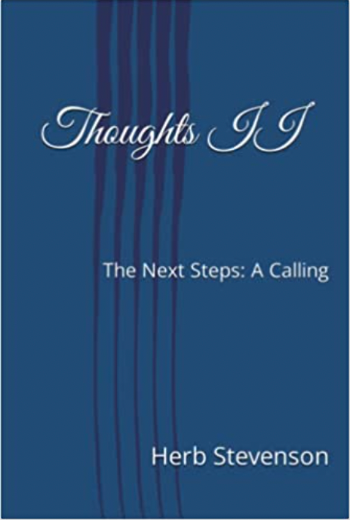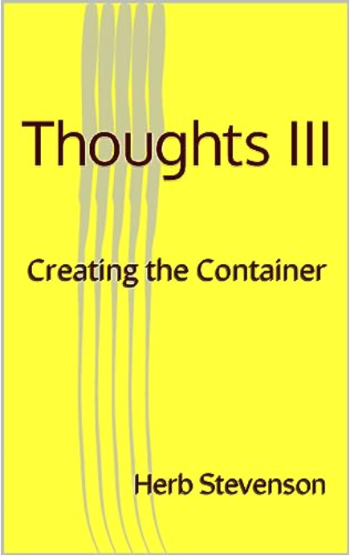

A book by Herb Stevenson, Volume 1. Learn more on Amazon.
Thoughts II:
The Next Step: A Calling

Volume 2 of 3. Learn more on Amazon.
Thoughts III:
Creating The Container

Volume 3 of 3. Learn more on Amazon.
To Lead
Read the article about training with Herb Stevenson in ALN Magazine.
See the article...
Appreciative Inquiry
Tapping into the River of Positive Possibilities
by Herb Stevenson
Background
David Cooperrider realized that most organizations are predisposed towards “what is wrong” within the organization. He attributed this predisposition to the inculcated problem-solving mentality of the scientific method which tends to ignore “what is working”, “has gone well”, and “does not need fixed” components of the organization. In developing Appreciative Inquiry, Cooperrider refocused the attention away from the critical, more pessimistic perceptions of the organization to the supportive, more optimistic behaviors. In doing so, he sought to harness the untapped creative energies by redirecting the attention away from object relations problem solving and towards an appreciative inquiry of the stories of success held by the people within the organization. Therein, a sense of community is created as commonality, pride, and creativity are unleashed. The end result is a new perspective of the organization and of what is possible. (Cooperrider & Dutton, 1999; Cooperrider & Whitney, 1999; Cooperrider et. al. 2000)
Critical Premise
A critical premise within the Appreciative Inquiry method is that we are constantly creating our perceived reality. Some of this creating of perceptions is influenced by what we believe, which becomes an unchecked and rarely cleaned filter of what we can see. For example, if an organization has a core belief that revolves around being the best or the fastest or biggest, this belief implies that the firm must constantly find a way to improve. From a management perspective, this seems like a worthy goal. However, from an employee perspective, it also means that whatever work is completed is never “good enough”. Hence, the core belief that the firm must constantly improve connotes to all within the firm, that no matter what is accomplished, or how well the firm performs, there is something inadequate, incomplete, and/or not good enough about the organization and each individual within. Cooperrider referred to this behavior as deficit thinking based on the problem solving predisposition of most organizations. More importantly, by paying attention to what is wrong, inadequate, or not good enough, we emphasize and amplify them by creating a language of deficit that permeates our thoughts and our words.
It is at this juncture that many CEOs feel like pulling their hair. Focused on the problem solving aspect of deficit thinking, the organization begins to resist every attempt to improve performance or to follow corrective action policies. Management has one perception and the employees have another of what it means to solve problems. Management views problem solving in the form of growth expectations, service quality, and efficiency as the core of good business. Employees view problem solving as a never ending process of frustration that negates all humanness within the organization. Hence, not only does the organization see what it believes, but the very act of believing it creates it. (Bushe, 1995) The organization becomes enmeshed in isolated and incompatible perceptions. Neither side tends to be able to see the other’s perceptions because it does not fit into each groups believed and therefore perceived reality. Unless the collective has experienced a clear and believable bridge between the two perceptions, any talk about the situation becomes another exercise in affirming the existing beliefs.
Comparison of Two Views
| Problem Solving | Appreciative Inquiry |
| "Felt need" Identification of Problem |
Appreciating and valuing the best of "what is" |
| Analysis of Causes | Envisioning "what might be" |
| Analysis of possible solutions | Dialoguing "What should be" |
| Action planning (Treatment) | Innovating "What will be" |
| Basic Assumption: An organization is a problem to be solved. | Basic Assumption: An organization is a mystery to be embraced. |
Appreciative Inquiry
The basic premise of Appreciative Inquiry could be applied to how an organization views a glass of water. If it is viewed as half empty, the organization would probably be oriented towards problem solving and deficit thinking---how do we fill the glass to the brim or how do we catch the culprit drinking our water. If the glass is viewed as half full, the organization would probably be positively oriented towards "what works" and on enjoying the small and/or individual successes of each day.
Appreciative inquiry searches for "what works" through the numerable individual success stories within the organization that are embedded with excitement, creativity, and pride. Once discovered, these stories are shared throughout the organization. Individuals are recognized and affirmed as contributing and successful members of the organization. Confidence and commitment to more success begin to permeate the individual and organizational belief systems. What is "wrong", "inadequate" and/or "not good enough" moves out of awareness as the organization taps into the river of positive possibilities. It becomes clear that the future can be built on the successes of the past.
| Assumptions of Appreciative Inquiry |
| 1. In every society, organization, or group, something works. |
| 2. What we focus on becomes our reality. |
| 3. Reality is created in the moment, and there are multiple realities. |
| 4. The act of asking questions of an organization or groups influences the group in some way. |
| 5. People have more confidence and comfort to journey to the future (the unknown) when they carry forward parts of the past (the known). |
| 6. If we carry parts of the past forward, they should be what is best about the past. |
| 7. It is important to value differences. |
| 8. The language we use creates our reality. |
An Important Diversion
Appreciative inquiry relies on two important discoveries. First, Carl
Jung came to the conclusion that most important problems are rarely
solved. Rather, they are outgrown as interest shifts to something new
or more intriguing, thereby leaving the original problem to fade away.
Second, brain research has discovered that
the human brain does not register or hear the word "not". Rather,
to alter human behavior, it is more effective to positively tell the
person what is expected instead of telling him or her what is not wanted.
Returning to appreciative inquiry, as the individual and organization
reveal "what works" within the organization, it is shifting
the focus away from problem solving and things employees are not to do
and towards positive examples of what is successful within the organization.
Pollyanna
Much of the criticism towards appreciative inquiry relates to a disbelief in using a positive frame of reference instead of a problem solving focus. It is often framed as being a Pollyanna, where the individual is accused of wearing rose colored glasses and only seeing the good, the pleasant, the positive things in life to the exception of the real business at hand.
Appreciative inquiry does not negate nor ignore problems. Rather, it shifts the lens and/or frame of reference that is used to define what is happening. Instead of looking for “what’s wrong” or “needs fixed” the firm focuses on “what’s right” or “what’s working” and seeks to do more of it. In short, appreciative inquiry suggests that you can create change by paying attention to what you want rather than paying attention to problems. (Bushe, 2000, 99)
For example, after experiencing an appreciative inquiry, the organization tends to develop more trust between individuals. This trust leads to soliciting support to find a successful response to a situation. Responses to such requests tend to be framed in ways that other employees have successfully addressed similar situations. Combined, appreciative inquiry tends to move away from identifying all situations as problems and therefore from hiding problems from others so that the person does not look incompetent. Instead, the frame of reference is towards trusting what has worked in the past and the revealing of situations to determine if others may have experienced the situation and how they successfully addressed it.
Collective Vision
Building on the idea that “we see what we believe”, appreciative inquiry seeks to change the belief building and reinforcing frame of reference. Instead of insufficiency, inadequacy, and incompetency, the focus moves toward wholeness, completeness, and skillfulness. As such, appreciative inquiry seeks to surface existing individual and collective images of what each individual and the entire organization has been and can be at its very best.
The Appreciative Process
Appreciative inquiry involves five phases: (1) Affirmative Topic Choice, (2) Discovery—Appreciating, (3) Dream—Envisioning Results, (4) Design—Co constructing, and (5) Destiny—Sustaining.
Figure 1. Phases of Appreciative Inquiry
| Discovery What Gives Life? Appreciating: the best of “what is” |
||
| Destiny How to empower, learn, adjust and improvise: Sustaining |
|
Dream What might be: Envsioning results |
| Design What should be the ideal?: Co-constructing |
Although, the five phases are often portrayed as a circle, with a circular movement that suggests a linearity to the process, I prefer to refer to it as a wheel where the actual process is not around the outside circle, but a constant motion of moving from the center of the circle outward to the applicable phase and back to the center. This alternative perspective enables the complexity of the process to more clearly unfold. Appreciative inquiry is an exploration of an affirmative topic that has been chosen for study. This study entails moving into and through four phases, constantly returning to the original topic within the center. Keeping the affirmative topics chosen at the center or core of the process ensures the deepening process that is sought.
Affirmative Topic Choice
Topic selection begins the adventure into appreciative inquiry. It requires searching for the positive description of what is desired by the organization. Because individually and collectively we move towards whatever we study, the selection of the AI topics is critical. It is the foundation of the entire process. Hence, the topic choice process should be an affirmative act—
- that will lead to what gives life to the organization,
- that represents what the organization wants to discover or learn more about,
- that evokes conversations of the desired future, and/or
- that reveals more about what they want to see grow and flourish in
their organization.
In a nutshell, the topics should be bold—something that stretches the organization beyond the status quo, desired—something that you really want to see happen, and stimulating—something that has the potential to energize people, mobilize forces, and be strategic.
Preparing for Topic Selection
The selection of the AI topics can be supported through an exercise. As an initial exploration, each member of the AI team or summit will complete the following exercise by recording their responses on a piece of paper—
- Describe a peak experience or “high point”
- What things do you value most about —
» yourself?
» the nature of your work?
» the organization? - What do you consider to be the core factor that gives “life” to the organization?
- What three wishes would you make to heighten vitality and health in this organization?
Once each person has completed the exercise, the AI team divides itself into
pairs. Each person takes a turn at interviewing and being interviewed. The
questions just answered are used with the interviewer probing deeper into the
answers, getting excited, being surprised, curiously inquiring. Listen intently.
Pause before asking questions. Each pair joins to form a group of 8-12 people.
The interviewers report to the group what was learned from the interview. A
list is created on newsprint/poster
boards.
Three to five themes are developed from the lists. Using themes listed on the newsprint, develop topics that can be affirmatively explored. Consider the following ways to create an affirmative topic—
- reversing a problem into a positive statement, customer complaints to customer compliments.
- using improbable word pairings to deepen the meaning such as congruent commitment, honest authenticity, radically clear communications, optimal integrity, meaning-making relationship, organizational optimism, and/or lightning fast consensus.
Once the topics are selected (three to five), we move into the discovery phase.
Discovery—What gives life (the best of What is)—Appreciating
The discovery phase involves a data collection and narrative exploration. It begins the process of revealing the positive, the successful, and the prideful experiences of the individual and collective. Through carefully developed interview questions based in the affirmative topic selection, the focus is to explore and enliven the stories that are shared through interviewing the defined group within the organization. Generally, the more reflective of the entire organization, the more effective the outcome.
The steps in the discovery phase are as follows:
- Identify stakeholders.
- Decide who will be interviewed.
- Develop interview protocol/questionnaire and distribute to team members.
- Decide on a method/format for organizing the data
» How will findings be recorded?
» How will the team’s data be compiled?
» Who will do it? - Conduct the interviews
- Create a method for capturing the best stories, data, and visions.
The intent is to energize both the interviewers and interviewees as they share their experiences and history with the organization, as well as their values and wishes for the future. Noteworthy is that this is a mutual learning process for the interviewer and interviewee. Within this learning process, the frame of reference of the organization begins to shift from problem solving and/or deficit thinking to possibility evolving and successfully working.
Interview Protocol
The interview protocol begins the process of changing the frame of reference of the individual and the collective. As Cooperrider and Whitney note, we need to remember throughout this process that
What we ask determines what we find.
What we find determines how we talk.
How we talk determines how we imagine together.
How we imagine together determines what we achieve.
The interview protocol includes three parts: (1) Developing Stage Setting Questions, such as what do you value most about yourself, your work, and your organization? (2) Establishing the topic or subject matter surrounding the appreciative inquiry and developing questions with lead-ins, and (3) Developing a closing questions that conclude the interview and begins to open the sense of possibility, such as—
- What are the core factors that give life to this organization?
- Looking toward the future, what are we being called to become?
- What three wishes do you have for changing the organization?
Interview Summary
Each interview needs to be recorded so that a determination of themes can be completed and that the stories can be shared in such a way as to build community awareness and pride as well as ensure individual confidentiality. Typically, an interview summary sheet is developed that includes some variation of the following:
- Name of the interview and the date of the interview
- What was the most quotable/best quote that came out of this interview?
- What was the most compelling story that came out of this interview?
- List 1-3 themes that stood out for you during the interview.
Dreaming—What might be—Envisioning Results
The dream phase of appreciative inquiry begins the process of what could be. Whether we call it dreaming, envisioning, or imagining, the focus is to think about possibilities beyond the realm of present day thinking. It is a brief window of opportunity. The collective interviews have built a cache of stories of successful ways of being within the organization. If these stories are grounded into the organization’s psyche, they will become the foundation for building the organization’s future. In short, the frame of reference will begin to shift through the stories that have been told.
Dream Practice
The dreaming process involves forming small groups of 8-12 people. These groups review the summary sheets from the interviews. The focus is to build common ground within the group based on the success stories and questions based on dreams, hopes, and visions of the future of the organization from the original interviews.
The groups then discuss their individual visions of the ideal organization and describe what would be happening 5-25 years into the future. From this discussion, the group’s collective vision is developed. (If desired, facilitators can direct the process based on themes of the future that have surfaced from the interview process.) Typically, the dream or strategic focus becomes articulated as a vision of a better organizational world, a powerful purpose, and a compelling statement of strategic intent. (Cooperrider & Whitney)
Each group is encouraged to step out of the box or to bring more of whom they are into the room by preparing an expressive enactment of their group dream of, hope for,or vision of the organization. This enactment can be Parodies or Poetry, TV or Radio commercials, Jingles or Songs, One Act Plays or Mime, Play by Play descriptions or Instant replays, etc. The expressions of these dreams are presented to the other groups.( As a side note, this process tends to open the door of playfulness which leads to creative expressions.)
Possibilities
The outcomes from this process will be the surfacing of common ground between
the groups. This common ground creates a collective awareness that more than “just
me” has a specific dream about the organization. Therein, the dream
moves
towards the next step of being manifested into reality.
Design—What should be—the ideal—Co-constructing
The design phase begins to build the bridge from the best of “what is” (present) within the organization towards a speculative or intuitive “what might be” (future). Provocative propositions are developed as bold statements of the organization of the future as if it has already happened. Using the themes and dreams that have evolved from the prior three phases, the design phase seeks to create the social architecture to materialize the desired, ideal organization. Questions such as what would we (our organization) look like if it were designed in every way to maximize and preserve the topics that were chosen for study.
Returning to groups of 8-12, the focus of developing provocative propositions is threefold:
- 1) From the interviews in the discovery phase and the future images from the dream phase, find examples of the best, the ideal, the desired.
- 2) Reflect and dialogue on what circumstances made the best, the ideal, the desired possible. Record these circumstances in detail.
- 3) Take the stories and envision what might be. Write an affirmative statement that describes the idealized future as if it has already happened.
To ensure comprehensiveness, the design of the social architecture might include
such organizational components as—leadership, strategy, culture, societal
purposes, shared values, management and business practices, ethics and social
responsibility, competencies, stakeholder relations, structures and systems,
desired results in financial or diversity or other areas.
Destiny—how to empower, learn, adjust, improvise—Sustaining
The final phase of appreciative inquiry is destiny. Appreciative inquiry generates
a repatterning of our relationships with our self, others, and how we perceive
the world. Our ways of knowing the world changes from the socially and culturally
contrived to the personally and professionally chosen. We know that we create
the organizations in which we live. To encourage this process, the appreciative
inquiry process can be integrated through using an appreciative questionnaire.
Typically, the following questions can support the individual process.
- What about the appreciative inquiry process most enlivened you?
- What excites you most about introducing appreciative inquiry to your clients/organization?
- What appreciative inquiry competencies have you discovered within yourself?
- What’s your favorite story about appreciative inquiry?
- What visions do you have for taking this process to a new level within your organization?
At an organizational level, the destiny phase suggests that if the appreciative inquiry process of positive transformation is supported through empowering employees to connect, cooperate and co-create, the results will continue to surface in new, innovate, and bold ways.
Application
The actual process can be adapted to almost any situation. For example, it can be used for strategic planning, diversity management, or any other critical issue related to the functioning of the organization.
For example, the strategic planning process might include the following steps:
Step 1: An Ai consultant provides a full day explaining/training
the theoretical basis for the work. The Ai consultant helps the Ai team construct
an Ai interview protocol.
Step 2: The Ai team uses the protocol
to interview all or a significant majority of stakeholders.
Stakeholders typically include all or a significant number
of people in the organization as well as people with a
vested interest, such as family, suppliers, and/or customers.
Step 3: The Ai team brings the data to three to
five day retreat, where it develops a written set of possibility
propositions from the collected interview data.
Step 4: The Ai consultant supports the Ai team as
it works to incorporate the possibility propositions into its mission
and vision.
Step 5: The Ai team assesses the impact the retreat has had on it and the potential
impact on the organization.
Ai Consultant time including Ai Training (1), Retreat (3-5), and Follow-up days (4) eight to ten days. Ai Team time, including Ai training (1), Interviews (2-5), and Retreat (3-5), is six to eleven days.
Roles and Responsibilities
| Before | During | After | |
| Ai Consultants | Introduce Ai to the organization Focus on the |
Train groups in Ai Support the Core Team Facilitate the Summit |
Assist the organization to integrate Aim into daily practices |
| Ai Sponsors | Become Plant the Ai seed |
Champion Ai in the organization Participate—as an equal, essential voice. |
Ask, how might we
take an Ai approach to Lead by affirmation |
| Ai Core Team | Become knowledgeable in Ai |
Select affirmative Create Interview Determine interview Communicate “best” stories |
Use Ai as a daily practice. |
| Ai Interviewers | Become knowledgeable in Ai |
Ai Conduct interviews Summarize “Best” stories |
See Ai as a daily practice |
| Ai Summit Participants |
Conduct interviews or be interviewed Review interview |
Engage in discovery Date to dream Design the ideal |
Sustain Ai Create new systems and structures using Ai Share success stories |
References
Bushe, Gervase, R. (1995) Advances in Appreciative Inquiry as a Organization
Development Intervention. Organization Development Journal, Vol. 13, No.
3. 14- 22.
Bushe, Gervase R. (2000) Five Theories of change Embedded in Appreciative Inquiry.
in Cooperrider, David, Sorensen, Peter F., Whitney, Diana, Yaeger, Therese
F. (Eds.) (2000) Appreciative Inquiry. Champaign, Illinois: Stipes Publishing.
99-109.
Cooperrider, David, L. & Whitney, Diana, (1999) Appreciative Inquiry. San
Francisco: Berrettt-Koehler.
Cooperrider, David, L. & Whitney, Diana, (2000) A Positive Revolution in
Change: Appreciative Inquiry. in Cooperrider, David, Sorensen, Peter F., Whitney,
Diana, Yaeger, Therese F. (Eds.) Appreciative Inquiry. Champaign, Illinois:
Stipes Publishing. 3-27.
Cooperrider, David, L. & Whitney, Diana, (1999) A Positive Revolution in
Change: Appreciative Inquiry. in Holman, Peggy and Tom Devane (Eds.) The Change
Handbook, San Francisco: Berrett-Koehler, 245-262
Cooperrider, David and Dutton, Jane E. (Eds.) (1999) Organizational Dimensions
of Global Change: No Limits to Cooperation. Thousand Oaks, Ca.: Sage.
Cooperrider, David, Sorensen, Peter F., Whitney, Diana, Yaeger, Therese F.
(Eds.) (2000) Appreciative Inquiry. Champaign, Illinois: Stipes Publishing.
Hammond, Sue Annis, (1998) The Thin Book of Appreciative Inquiry. 2nd Ed. Plano,
Texas: Thin Book Publishing Co.
We Appreciate Your Feedback
Please let us know if you found this article interesting or useful. We will not submit this information to any third parties.

